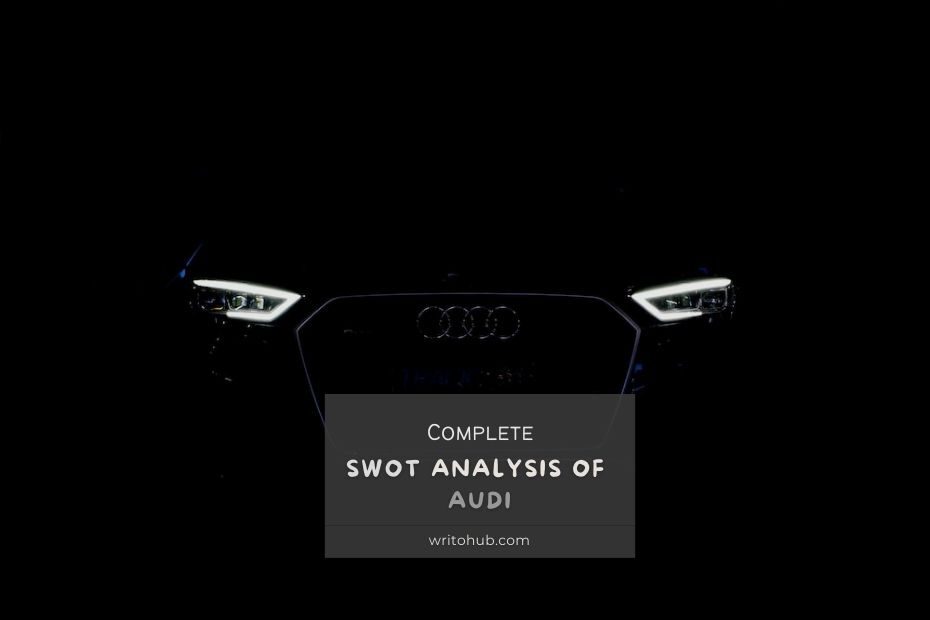Audi, a renowned German automobile manufacturer, is celebrated for its luxurious cars, cutting-edge technology, and strong commitment to innovation.
As the automotive industry faces constant challenges and fierce competition, conducting a SWOT analysis of Audi can provide valuable insights into its strengths, weaknesses, opportunities, and threats.
By examining these factors, Audi can further strategize to maintain its position as a premium brand in the global automotive market.
Strengths in the SWOT Analysis of Audi
- Brand Reputation: Audi has built a strong and prestigious brand image over the years, known for its high-quality craftsmanship and engineering excellence. The four-ring logo has become synonymous with luxury and innovation, attracting a loyal customer base.
- Technological Advancements: Audi is at the forefront of automotive technology, continually introducing innovative features in its vehicles. From cutting-edge infotainment systems to autonomous driving capabilities, Audi stays ahead in embracing new technologies.
- Extensive Model Lineup: Audi offers a diverse range of models, catering to different segments of the market. From compact sedans to powerful SUVs and electric vehicles, the brand ensures a comprehensive product portfolio to meet various customer preferences.
- Global Presence: Audi has a strong international presence, with a well-established network of dealerships and production facilities in key markets around the world. This extensive reach enables the brand to tap into diverse customer demographics.
- Research and Development: The company invests heavily in research and development, fostering constant innovation and improvements in vehicle performance, safety, and sustainability. This dedication allows Audi to stay competitive and adapt to changing market demands.
Weaknesses in the SWOT Analysis of Audi
- High Price Point: Audi’s premium positioning means that its vehicles often carry higher price tags compared to mainstream competitors. This exclusivity may limit the brand’s appeal to a broader audience, particularly during economic downturns.
- Dependence on Key Markets: While Audi enjoys a global presence, its sales heavily rely on a few key markets, which could make the brand vulnerable to regional economic fluctuations and changes in consumer preferences.
- Limited Electric Vehicle Portfolio: Although Audi has made strides in the electric vehicle (EV) segment with models like the e-Tron, its EV portfolio is still relatively limited compared to some competitors. This could hinder the brand’s ability to fully capitalize on the growing EV market.
- Environmental Concerns: The automotive industry faces increasing scrutiny over environmental impacts. As a luxury automaker, Audi needs to continually address concerns regarding emissions, sustainability, and carbon footprint to maintain a positive brand image.
- Competition: Audi operates in a highly competitive market, facing challenges from other luxury automakers, as well as emerging electric vehicle startups. Maintaining a competitive edge requires constant innovation and differentiation.
Opportunities in the SWOT Analysis of Audi
- Electric Mobility: With the global push towards sustainable transportation, Audi has the opportunity to expand its EV lineup and invest further in electric mobility solutions. By doing so, the brand can attract environmentally-conscious consumers and remain relevant in a rapidly changing automotive landscape.
- Autonomous Driving: The development of autonomous driving technology presents a significant opportunity for Audi to pioneer self-driving features and redefine the driving experience. Investing in this area can help Audi position itself as a leader in autonomous vehicles.
- Emerging Markets: Audi can explore untapped markets and expand its footprint in regions with growing economies and rising consumer purchasing power. This expansion would enable the brand to diversify its revenue streams and reduce dependence on specific markets.
- Digital Transformation: Leveraging digital platforms and offering online sales channels can enhance the customer experience, attract younger demographics, and adapt to changing consumer buying habits.
- Luxury Services: Beyond the sale of vehicles, Audi can explore luxury services and experiences for its customers, such as concierge services, personalized vehicle customization, and premium ownership benefits.
Threats in the SWOT Analysis of Audi
- Economic Uncertainty: Fluctuations in global economic conditions can impact luxury vehicle sales, as consumers may cut back on discretionary spending during economic downturns.
- Trade and Tariff Wars: Audi’s global operations make it susceptible to trade disputes and tariff wars between countries, potentially affecting production costs and sales volumes in specific regions.
- Regulatory Changes: Evolving regulations related to emissions, safety standards, and import/export restrictions can pose challenges for Audi’s product development and international operations.
- Disruptive Startups: Newcomers and startups in the automotive industry, especially those focused on electric and autonomous vehicles, could pose a threat to Audi’s market share if they successfully gain traction.
- Shifting Consumer Preferences: Changes in consumer preferences, such as a shift away from traditional car ownership or a preference for shared mobility services, could impact Audi’s business model and market demand.
Conclusion
Audi’s SWOT analysis highlights its strong brand reputation, technological leadership, and global presence as key strengths.
However, the company must address challenges related to price positioning, environmental concerns, and growing competition.
By capitalizing on opportunities in electric mobility, autonomous driving, emerging markets, digital transformation, and luxury services, Audi can drive towards excellence and maintain its position as a leading luxury automotive brand in the global market.
Strategic adaptation and continuous innovation will be essential to navigate the evolving automotive landscape successfully.
